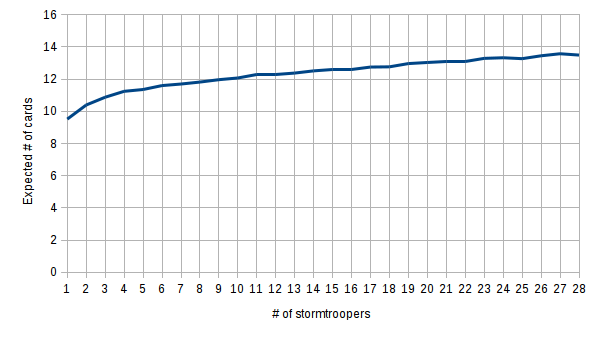So, I made a game dynamic simulator for Risk: Star Wars Edition. The usual rules, it’s a WIP, it’s not hardened, if you use it to control a nuclear power plant then it’s at your own risk.
The code’s at: https://github.com/lkolbly/sw-ksirk
The rules and API are on the GitHub page, so I won’t mention those here. But I will mention a few quick results that one can get just by statically analyzing the game.
Death Star Attack
For an attack by the Death Star to succeed, you must get a 5 or a 6 on 2d6 (two six-sided dice, if you don’t play D&D). In other words, if not (both dice are 1-4), or 56% of the time. Just over half.
Attack on Death Star
Such an attack requires rolling a natural 6. So how many attacks should you need to destroy it?
Stack Overflow is useful here: E = 6 (http://math.stackexchange.com/questions/42930/what-is-the-expected-value-of-the-number-of-die-rolls-necessary-to-get-a-specifi)
Attacking Ships
X-Wings and TIE fighters each require a 3 or better to destroy, so how many attacks should it take to destroy a fleet of 5 X-Wings or 4 TIE fighters? (one attack is defined as a ship-attack - i.e., a die rolled)
We can calculate that the average attack will destroy 0.66 ships, so 5 X-Wings would take 7.5 attacks on average, and 4 TIE fighters would take 6 attacks on average.
Y-Wings require a 4 or better, so the average attack destroys half a ship. A fleet of 4 then takes 8 attacks on average.
B-Wings require 5 or 6, so the average attack destroys 0.33 ships. A fleet of 3 takes 9 attacks on average.
The Falcon has 6 hitpoints, and requires a 5 or 6 to do damage. Thus it takes 18 attacks.
The Executor has 8 hitpoints, and requires a 5 or 6 to do damage. It takes 24 attacks (!).
Attacking Fleets
The game starts with 20 X-Wings, 16 Y-Wings, 12 B-Wings, 24 TIE fighters, 1 Falcon and 1 Executor.
Destroying the rebel fleet takes (on average, ignoring Death Star shots) 30 hits for the X-Wings, 32 for the Y-Wings, 36 for the B-Wings, and 18 attacks for the Falcon, for a total of 116 attacks. At 5 attacks per card, this is just over 23 cards.
Destroying the imperial fleet is more complicated, since TIE fighters can spawn. If no fighters are spawned, however, it takes only 60 attacks to destroy the entire fleet. If all 56 TIEs are spawned, it takes 108 attacks.
This is all assuming that the ships are segregated by type - i.e. you only attack squares with a single ship type on them at a time. If a space has multiple ship types on it, the expected time could be lower. So this is an upper bound on the expected value.
Lightsaber Battle
It takes 7 lightning cards for the Empire to win using solely lightning cards. However, the average lightsaber card advances 2.5 hitpoints, so the Empire can win in (on average) 5.2 cards, and the Rebellion in 4.8 turns (or 4.6 if they use the hat). Thus on average the Rebellion gains 0.4 cards, whereas the Empire loses 1.2 cards.
Of course, the strategic advantage of this is that you get cards all at once, so it may pay off in less quantifiable ways depending on your situation.
Shield Generator
This part is the hardest to calculate analytically, so I wrote a short function to simulate it in a monte-carlo fashion (findExpectedShieldRolls in the GitHub repo).
The results are that, on average, 9.5 rolls must be made if there are no stormtroopers, and 13.5 must be made if there are entirely stormtroopers (it takes 28⁄3, or just over 9, cards to completely fill the track with stormtroopers, so it’s not in general worth it).
The function goes more in-depth, and finds the expected number of cards used if the last N spaces are filled with stormtroopers, for every possible value of N (from none to all).
The results make a nice graph:

As you can see, stormtroopers later (where the spaces are higher in value, at the left on the graph) are worth more than stormtroopers earlier (where the spaces are lower). The first stormtrooper placed (if you were to place it on the last spot) raises the expected value by half a card all by itself. The first six stormtroopers placed (on the last six spots) raise the expected number of cards by almost 2.5, for an investment of only 2 cards (each card places 3). In fact, looking at the raw data (with a spreadsheet program), the break even point is after 2 cards/6 stormtroopers. 1 card (3 stormtroopers) raises the expected rolls by 1.73, for a marginal benefit of 0.73 cards.
Too long, didn’t read: It’s worth it to place stormtroopers on the last 6 spots, but before that it’s a losing battle.
